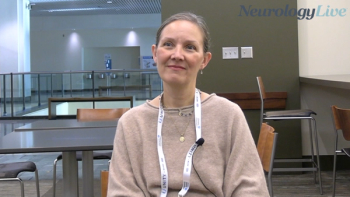
Remyelination As The Next Frontier in Multiple Sclerosis
The next important area of therapeutic development in MS appears to be in disease damage repair.
Ari Green, MD, MCR
In multiple sclerosis (MS), there has been an influx of therapies in recent years, broadening the horizons for thousands of patients. Although these therapies are disease-modifying, nothing that can repair the damage done by the disease is clinically available.
For Ari Green, MD, MCR, the medical director of the UCSF Multiple Sclerosis Center and director of the UCSF Neurodiagnostics Center, there is a chance this could happen, though. One of the most rapidly growing areas of research and development in MS has been in remyelination. This is where Green’s research is focused.
To gain some of his insight into this development, NeurologyLive spoke with Green at the 34th Congress of the European Committee for Treatment and Research in Multiple Sclerosis (ECTRIMS) in Berlin, Germany.
NeurologyLive: What is the next big step in treatment development for multiple sclerosis?
Ari Green, MD, MCR: In terms of remyelination or repair, I think this is the next important area of therapeutic development in MS. We have immunotherapeutic agents, immunomodulatory and targeted immunosuppressive agents that, at least partially in some instances, and almost, in some instances appear to almost fully, prevent new damage and new injury from happening. And yet, still, a substantial portion of people despite that fact, still go on to develop some progressive disability.
We recognize that once someone is clinically identified to have the disease, that's not when the disease actually started. The disease is actually probably causing damage for a significant period of time in advance of the initial clinical presentation or the diagnosis, and, in fact, that's a diagnostic requirement. One consistent feature of all the diagnostic criteria for establishing MS has always revolved around dissemination in time and space. Which means people have to have not just 1 singular lesion, but multiple lesions occurring and multiple different periods of injury occurring at multiple different times. That damage and injury that is that is evident at the time of initial presentation or diagnosis is not something that the existing therapeutic modalities address. They don't have any capacity to induce repair. They might help calm the waters enough so that endogenous repair could at least partially take place, but we know endogenous repair is limited and the goals with remyelinating therapeutics is developing agents that can actually enhance the capacity for endogenous repair.
How did this thinking come about?
It's been known for a better part at least 2 decades that there's a unique population of cells that makes up probably about 5% of the cells in the adult human central nervous system that can turn in to oligodendrocytes. Just as a quick refresher for anybody who doesn't remember this, oligodendrocytes are the cells that make myelin, they wrap axons, and it's only the terminally differentiated oligodendrocytes, so the cell at its full maturation, that can make myelin and then sheath axons. That's necessary for the maintenance of or for the restoration of saltatory conduction—rapid fast conduction of action potentials through the central nervous system is dependent upon the presence of normal myelin architecture. Targeting the disease is myelin—how do we restore that; how do we bring oligodendrocytes back?
The oligodendrocytes are evident, they're found tiled throughout the brain, both in normal health and in disease, and again they make up 5% of the cells of the adult central nervous system at least. Those cells are there. How do we get them to do what they should otherwise be doing, which is after demyelination happens, recovering and restoring that myelin? If we took an animal and we demyelinate the animal, either chemically or in a relatively targeted way dissolves or damages myelin, or we induce an inflammatory response that targets myelin, you will see some remyelination occur in a period of just a few weeks. In fact, that the chemical demyelination models where the kinetics are really well understood, 2 to 4 weeks after the demyelination happens, depending on the animal model and the age of the animal, you will see pretty robust remyelination. Why that doesn't that happen in humans and in disease and MS is not well understood.
But what we wanted to get at for therapeutics and the reason therapeutics are showing up right now, is the capacity to screen drugs that are capable of permitting or forcing those OPCs to differentiate—that's the new that's the new area of development. That screening methodology that identified new drugs that whole areas of biology has matured in the last 5 years or so, and that's what's really led to identification of drugs and then the first drugs being tested in people.
Transcript edited for clarity.
Newsletter
Keep your finger on the pulse of neurology—subscribe to NeurologyLive for expert interviews, new data, and breakthrough treatment updates.



































